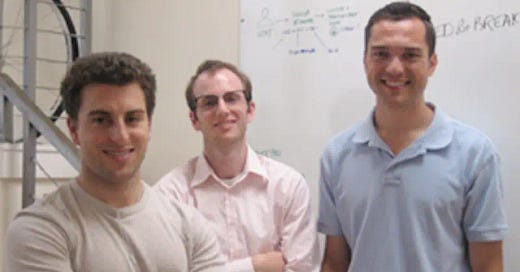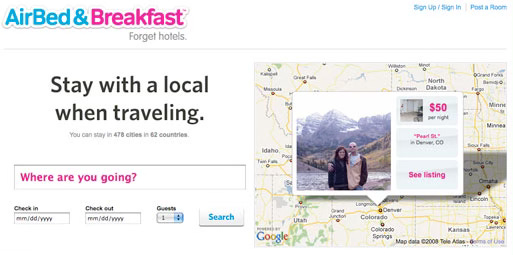The Airbeds Trap: lessons in market orientation from Airbnb
Why founders (and leaders) struggle to see the market they’re really in
In 2007, Brian Chesky and Joe Gebbia had a great experience hosting people on airbeds in their homes during a design festival. Their guests had found a cheaper alternative to local hotels, Brian and his flatmates had made a little extra cash, and AirBed&Breakfast was born.
A year later however, the start-up was struggling.
Positioning themselves as "an affordable alternative to hotels”, they competed with hostels and boarding houses - a tiny small slice of the domestic travel market. Investors weren't interested in something so niche.
And even within that market, renting airbeds on the floor of a stranger’s apartment was a pretty weird idea for most people.
In fact CEO Brian Chesky remembers thinking that Space X and their promise of life on Mars seemed more plausible to most people than their idea of sleeping in other people’s homes: “It was easier for ppl to imagine living this way on Mars than to imagine living differently on this planet.”
Customers and investors just couldn’t see past their mental model of what travel accommodation looked like.
But Brian and his co-founders were also trapped inside their own mental model of what their business was, rooted in the founding story of their first hosting experience.
In March 2008 at SXSW, someone asked Brian if they could use AirBed&Breakfast to rent out an extra bedroom in their house.
Brian: “Do you have an airbed?”
Customer: “er..no”
Brian: “Well i guess you could buy an airbed and put it on your bed?”
Customer: “….”
Despite the initial hesitancy, the team quickly realised they would be crazy to turn this customer down and so “we condoned real mattresses on the platform, but you HAVE to make breakfast”.
This allowed them to still stay (half) true to the name and spirit of the company: Air Bed & Breakfast.
Not long afterwards, a musician friend asked Brian if he could rent out his entire home while he was away on tour.
This sparked a huge debate inside the company…
“How could this be possible?? He won’t be there to make breakfast!!!!”
It felt so far removed from their vision it was hard for the team to get their heads around.
One team member even suggested that “maybe the host could come back in the morning to make breakfast?”.
It seems crazy in hindsight that the team didn’t immediately jump on this use case as the future of the business.
In fact it wasn’t until Brian met an investor from Sequoia who told him about ‘the $40bn vacation rental market’ that the penny really dropped and the founders finally found what they were looking for: a big addressable market, that existed mostly offline, ripe for disruption, and close enough to their existing business to get investors interested in funding.
The magic happened when they combined their foundational customer insight from those early experiments (authenticity, connection) with a big commercial insight (a fragmented offline rental market). That combination is what ultimately shaped their now-iconic positioning—‘belong anywhere’—a space no-one had ever occupied.
This is when AirBed & Breakfast became AirBnB.1
I love this story for two reasons…
It illustrates the power of shifting from a product to market orientation, but it also highlights how difficult it is to achieve the requisite level of detachment and perspective.
Brian and his co-founders couldn’t see past the original idea they had for the business, despite the fact they’d only been working on this idea for 18 months! It was barely a business.
So we shouldn’t be surprised when more established businesses with decades of success find it much harder to reframe the business they’re in and change the way they work or the customers they serve or in order to unlock new sources of growth.
This is a classic example of a ‘product orientation’ - leaders and especially founders, are so wedded to the product as it exists today, that they have a blindspot around the market they could be in.
Theodore Levitt warned us not to fall in love with the drill when what customers really want is a hole in the wall. Customer needs, not products, should define markets.
Clayton Christensen took this further with his idea of Jobs-To-Be-Done: maybe the hole in the wall is to hang a picture and redecorate a room, just like a milkshake might be “hired” to relieve the boredom of a long commute and keep hunger at bay until lunch. Understand the job, and you understand the market you’re really in.
Whether you talk about customer needs or Jobs, both thinkers championed the power of a ‘market orientation’ over a ‘‘product orientation. Step back from the features you’re building or the product you have, and regularly ask: what business are we really in?
Adopting this perspective and loosening the grip on how you define yourself is deeply, deeply uncomfortable but it’s the only way to identify new growth opportunities and reduce the threat of competitors entering your market with a more expansive and compelling proposition.
Here are four ways to make adopting a market orientation a little easier:
Combining market AND customer insights: it’s not enough just to speak to customers as your current customers might not have the insight into the broader market you should be serving. The customers responding to those early listings for airbeds weren’t going to be sharing their perspective on the $40bn vacation rental market. It took an outside perspective, from an investor, to shed light on a huge opportunity. The answer lay in combining the unique angle on hosting and hospitality the founders had stumbled upon, and applying this to a large, established, offline existing market.
Making gradually bigger bets rather than going all-in: for AirBnB it made sense to bet the farm given how embryonic the business was (and how few investors were interested in renting airbeds), but more established businesses with a successful core need to take gradual steps, making bets with an increased level of commitment assuming each bet pays off. DVD mail-order company Netflix first introduced streaming as a value-add option with a limited number of titles in 2007, then licensed their first exclusive streaming content in 2010 with shows like Breaking Bad, dipped their toe in the original content water with Lilyhammer in 2011, before making a huge bet with House of Cards in 2013, which was the same year that streaming subscribers overtook DVD subscribers. That’s six years of learning, adapting and bigger bets.
Go back to the future: just because we’ve only ever known a category or business in one form, doesn’t mean that it’s all that’s ever been. As Brian’s grand-father said to him after they made the pivot, AirBnB today is very similar to how people used to travel – boarding houses and guest houses – before the industrialisation of hotels and motels across America. A fresh look at the past can sow the seeds of a bigger future.
Take a global perspective: it's remarkable how differently markets evolve and needs are served in high growth countries across Africa, LATAM and Asia, and yet all the talk of innovation is centred on Silicon Valley. These countries account for 85% of the global population, and are often petri dishes of business model experimentation and category disruption. There is much to learn and be inspired by.
Over the last 12 months I’ve worked with a travel brand to rethink the business it’s really in—and how that could help win over more premium customers. I’ve helped a health-tech start-up go beyond its current niche and uncover new audiences for its life-saving opioid addiction treatment. And I’ve worked with a high street bank to reimagine the green finance market, identifying a major lending opportunity—and a new portfolio of propositions—to help customers upgrade their homes.
If you’re thinking about how to rethink the market you’re really in, or where the next wave of growth might come from, I’d love to chat.
What I’ve been reading
This was an insightful celebration of ‘structured messiness’, and how smaller, weirder, more diverse, and less polished urban spaces foster thriving neighbourhoods and more business experimentation, by Vaughn Tan.
Habsburg AI: the deformities in LLM output due to the inbreeding of models, fed on each other's increasingly inaccurate output. Named after the Spanish monarchy where incestuous relations resulted in genetic deformities, ill health, and ultimately, sterility.
Fascinating email discussion between Peter Thiel, Nick Clegg, and Zuckerberg debating the differences between Millennials and Boomers, and the role of Zuck in popular culture. Also, weirdly re-assuring that even Nick Clegg is not immune to receiving an email from his boss along the lines of ‘hey, I’ve been chatting to someone who doesn’t do what you do, but has really strong opinions on what you do, and why you may have been doing it all wrong, you should chat to him’. 😬
Ian Leslie on the hysteria around Adolescence.
You had me at ‘Skittle Factory Dementia Monkey Titty Monetization’. As you can guess from the title, this was a wonderfully bat-shit crazy article that I rarely come across nowadays: smart, funny and riddled with original metaphors.
How to be more emotionally intelligent (without trying too hard). I especially liked #28 “Judging others for showing off is often an indication that we’re struggling with our own desire to be seen” and #15 “Endless self-criticism is usually a sign that you want to be seen as valuable rather than to be of value.”
Until next time!
👋 I’m Michaeljon, a strategy and growth leader.
I help organisations identify and validate new growth opportunities by connecting deep customer understanding with commercial reality. I’m a people nerd who loves getting under the skin of a business—and I believe the magic happens at the intersection of the two.
Recent projects include:
✈️ Repositioned a global travel brand to target a more premium audience—developed new propositions, reimagined the customer experience, and shaped a five-year growth strategy to double the business.
🤸♂️ Led proposition and product strategy for a preventative health startup, helping them secure £1.5M in seed funding. Defined business model, pricing, and investor narrative as strategic advisor to the CEO.
🌿 Worked with a major UK bank to drive sustainable energy adoption and growth—designed innovative financial products, reframed their green finance strategy, and uncovered a £1bn+ annual lending opportunity.
🚑 Defined product strategy for a US health-tech startup in the opioid treatment space. Conducted ethnographic research to shape a life-saving proposition, identify target segments, and clarify market positioning.
Curious to explore how this kind of thinking could help you? Let’s chat.
Or you can find me on LinkedIn.
Listen to the full interview with Brian Chesky here:



